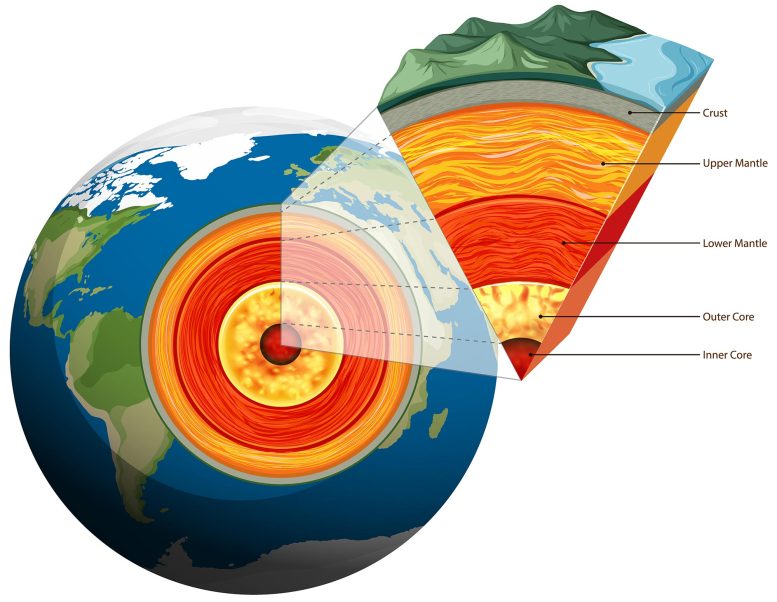Underground earthquakes reveal Earth’s inner secrets
- February 23, 2023
- 0
There may be a surprisingly liquid layer of rock at the bottom of the upper mantle around Earth, according to a new study by a University of Chicago
There may be a surprisingly liquid layer of rock at the bottom of the upper mantle around Earth, according to a new study by a University of Chicago

There may be a surprisingly liquid layer of rock at the bottom of the upper mantle around Earth, according to a new study by a University of Chicago scientist. The discovery was made by measuring continuous motion recorded by GPS sensors on the islands from a deep Pacific earthquake near Fiji. The study, published Feb. 22, NatureIt demonstrates a new method for measuring the fluidity of the Earth’s mantle.
“Although the mantle makes up the largest part of the Earth, there’s still a lot we don’t know about it,” said Sanyoung Park, a geophysicist at the University of Chicago and lead author of the study. “We think we can learn a lot more by using these deep earthquakes to probe these questions.”
We know surprisingly little about the Earth beneath our feet. The furthest anyone can dig is about seven and a half miles before the rising heat literally melts the drill bit. That’s why scientists had to use clues like how seismic waves move to understand the different layers that make up the planet, including the crust, mantle and core.
One thing that hinders scientists is accurately measuring the viscosity of the mantle layer. The mantle is the layer below the crust. It is made of stone, but under the high temperature and pressure at this depth, the stone actually becomes viscous – flowing very slowly, like honey or resin.
“We want to know exactly how fast the mantle is flowing because it affects the evolution of the entire Earth — how much heat the planet stores over how long and how Earth’s materials spin over time,” Park said. “But our current understanding is very limited and involves many assumptions.”

Park thought it might be a unique way to get measurements of mantle features by studying the effects of very deep earthquakes.
Most earthquakes we hear about in the news are relatively shallow and occur in the upper crust. But sometimes there are earthquakes that occur deep within the Earth, up to 450 miles below the surface. These earthquakes are not as well studied as shallow earthquakes, as they do not damage residential areas that much. But by reaching the mantle, Park thought they might offer a way to understand the mantle’s behavior.
Park and colleagues looked at one particular earthquake that occurred off the coast of Fiji in 2018. The magnitude of the quake was 8.2, but it was deep enough – 350 miles – to cause major damage or death.
However, when scientists carefully analyzed data from GPS sensors on several nearby islands, they found that the Earth continued to move after the earthquake was over. discomfort. Even years later, Tonga is still moving downward at about 1 centimeter per year.
“You can think of it as a jar of honey that slowly flattens out after you dip a spoon into it, but that takes years, not minutes,” Park said.
This is the first reliable observation of deformation after deep earthquakes; This phenomenon had been observed before for shallow earthquakes, but experts believed the effect would be too small to be observed for deep earthquakes.
Park and colleagues used this observation to understand the viscosity of the mantle.
“Even though the mantle makes up the largest part of the Earth, we still don’t know much about it.” — Assoc. Professor Sunyoung Park
While examining how the Earth has deformed over time, they found evidence of a layer about 50 miles thick at the bottom of the upper mantle that is less viscous (i.e. “liquid”) than the rest of the mantle. They believe that this layer can cover the entire world.
This low-viscosity layer may explain some of seismologists’ other observations that suggest there are slabs of “stagnant” rock at the bottom of the upper mantle at about the same depth that don’t move much. “It’s been difficult to replicate these features with models, but the weak level found in this study makes it easy,” Park said.
It also has implications for how the Earth transports heat, rotates, and mixes materials between crust, core, and mantle over time.
“We’re very excited. There is so much more to learn with this technique,” Park said.
Other co-authors on the paper were Jean-Philippe Avoac and Zhongwen Jean of the California Institute of Technology and Adriano Gualandi of Italy’s National Institute of Geophysics and Volcanology.
Source: Port Altele
As an experienced journalist and author, Mary has been reporting on the latest news and trends for over 5 years. With a passion for uncovering the stories behind the headlines, Mary has earned a reputation as a trusted voice in the world of journalism. Her writing style is insightful, engaging and thought-provoking, as she takes a deep dive into the most pressing issues of our time.